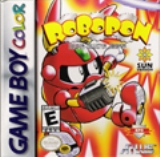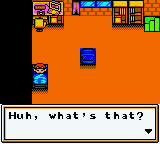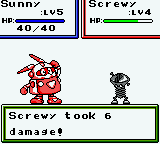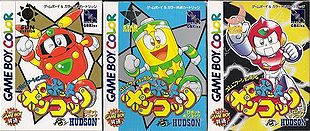
Robopon
Encyclopedia
Robopon Sun, Star and Moon Versions, or in Japan Robot Ponkottsu are handheld
role-playing games for Nintendo
's Game Boy Color
. Of the three games, only Sun was released in North America, on December 4, 2000 by Atlus
, while their original Japan releases were by Hudson Soft
. The games focus on a boy named Cody (his default name) and his adventures on his island with his robotic friends. They mostly resemble the Pokémon series of video games
, but also bear similarities to the SNES
game Robotrek
, published by game company Enix
(now part of Square Enix
).
 Within Robopon Sun, Star, and Moon versions, the player assumes the role of a child named Cody, whose grandpa is retiring and gives him the family business, a Robopon Dispatching Company. Cody travels around Porombo Island collecting Robopon and battling against the "Legend 7", the top-ranked Robopon collectors on the island. Each time Cody successfully beats one of the Legend 7, he takes his or her place in the ranking system.
Within Robopon Sun, Star, and Moon versions, the player assumes the role of a child named Cody, whose grandpa is retiring and gives him the family business, a Robopon Dispatching Company. Cody travels around Porombo Island collecting Robopon and battling against the "Legend 7", the top-ranked Robopon collectors on the island. Each time Cody successfully beats one of the Legend 7, he takes his or her place in the ranking system.
 Gameplay revolves around collecting, software upgrading, equipment swapping, and battling robotic characters in a similar manner to the Pokémon game series. To power up the Robopon, the player could add software
Gameplay revolves around collecting, software upgrading, equipment swapping, and battling robotic characters in a similar manner to the Pokémon game series. To power up the Robopon, the player could add software
and parts to them. Parts had varying amounts of space to store software and determined what sort of attacks the Robopon could use. For example, a Robopon could have an "Armgun" or a "Punch" part, and this software adds certain elements to the attacks. Furthermore, software could be added onto other parts, creating more powerful additions. For example, by equipping a "Thunder" software to a "Punch" part, the Robopon would be able to use "Thunderpunch". Software could also be mixed together to create special attacks - by mixing "Fire" and "Thunder" software, the Robopon would have the special move "Zapp!!". This software could also be removed. If you did so, the attack abilities it gave the Robopon would be removed as well. Because only Sun was released in the USA, not all of the original 153 Robopon were available because the others were located on the Star Version that was never produced in the US.
Robopon cartridges have an Infrared
panel on their top edge that allows them to trade information using waves much like a TV
or VCR remote, allowing the cartridge to react to different objects. For example, pointing a remote control
at the cartridges and pressing a button might boost the Robopons stats, or open a chest within the games. This feature was called the "GB Kiss". The game included over 150 different Robopon to use, with the first 2 releases and then over 168, with the release of Moon version, though some had to be upgraded, similar to Pokémon's evolution stages. The Robopon were classified as either Arm, Move, or Boot. Arm tended to have high offense, Move were fast, and Boot had the highest stats overall. Boot Robopon could not have their parts or software changed.
 While the USA only received the Sun Version, the Japanese first had the two main releases, then nearly a year later got the Moon Version, release. The Japanese version of the GB Kiss features a letter writing/sending feature, that can be accessed from the main menu, which can also send messages over the telephone. While for the USA release, only the sending Robopon feature is included on the GB Kiss. These versions are also compatible with the Japanese exclusive game Robot Ponkottsu 64: Nanatsu no Umi no Caramel with the Nintendo 64
While the USA only received the Sun Version, the Japanese first had the two main releases, then nearly a year later got the Moon Version, release. The Japanese version of the GB Kiss features a letter writing/sending feature, that can be accessed from the main menu, which can also send messages over the telephone. While for the USA release, only the sending Robopon feature is included on the GB Kiss. These versions are also compatible with the Japanese exclusive game Robot Ponkottsu 64: Nanatsu no Umi no Caramel with the Nintendo 64
's Transfer Pak
sequels were made; Robopon 2 Cross Version and Robopon 2 Ring Version, in a manner similar to that of the release patterns of different generations of Pokémon games. These games stars Cody traveling to another island but forgetting his Robopon. Subsequently, he has to find new Robopon, but instead of catching them he has to make them by finding different types of batteries and combining them in a method known as "Sparking". The game featured four-on-four battles, where all the Robopon the player had on him would battle against four opponent Robopon.
A Robopon game called Robot Ponkottsu 64: Nanatsu no Umi no Caramel
was made for the Nintendo 64
but was never released outside of Japan
.
.
Handheld game console
A handheld game console is a lightweight, portable electronic device with a built-in screen, game controls and speakers. Handheld game consoles are run on machines of small size allowing people to carry them and play them at any time or place...
role-playing games for Nintendo
Nintendo
is a multinational corporation located in Kyoto, Japan. Founded on September 23, 1889 by Fusajiro Yamauchi, it produced handmade hanafuda cards. By 1963, the company had tried several small niche businesses, such as a cab company and a love hotel....
's Game Boy Color
Game Boy Color
The is Nintendo's successor to the 8-bit Game Boy handheld game console, and was released on October 21, 1998 in Japan, November 19, 1998 in North America, November 23, 1998 in Europe and November 27, 1998 in the United Kingdom. It features a color screen and is slightly thicker and taller than...
. Of the three games, only Sun was released in North America, on December 4, 2000 by Atlus
Atlus
is a Japanese computer and video game developer, publisher, and distributor based in Tokyo, Japan, best known for developing the console role-playing game franchise Megami Tensei. The first Megami Tensei was a Nintendo Entertainment System video game published by Namco based on a trilogy of...
, while their original Japan releases were by Hudson Soft
Hudson Soft
, formally known as , is a majority-owned subsidiary of Konami Corporation is a Japanese electronic entertainment publisher headquartered in the Midtown Tower in Tokyo Midtown, Akasaka, Minato, Tokyo, Japan, with an additional office in the Hudson Building in Sapporo. It was founded on May 18, 1973...
. The games focus on a boy named Cody (his default name) and his adventures on his island with his robotic friends. They mostly resemble the Pokémon series of video games
Pokémon (video games)
Pokémon is a series of video games developed by Game Freak and Creatures Inc. and published by Nintendo as part of the Pokémon media franchise. First released in 1996 in Japan for the Game Boy, the main series of role-playing video games has continued on each generation of Nintendo's handhelds...
, but also bear similarities to the SNES
Super Nintendo Entertainment System
The Super Nintendo Entertainment System is a 16-bit video game console that was released by Nintendo in North America, Europe, Australasia , and South America between 1990 and 1993. In Japan and Southeast Asia, the system is called the , or SFC for short...
game Robotrek
Robotrek
Robotrek is a role-playing game released in 1994. It was published by Enix and developed by Quintet and Ancient for the SNES video game console.As its Japanese name implies, Robotrek was intended as a humorous game...
, published by game company Enix
Enix
The was a Japanese company that produced video games, anime and manga. The company was founded by Yasuhiro Fukushima on September 22, 1975 as and renamed Enix in 1982...
(now part of Square Enix
Square Enix
is a Japanese video game and publishing company best known for its console role-playing game franchises, which include the Final Fantasy series, the Dragon Quest series, and the action-RPG Kingdom Hearts series...
).
Story

Gameplay

Computer software
Computer software, or just software, is a collection of computer programs and related data that provide the instructions for telling a computer what to do and how to do it....
and parts to them. Parts had varying amounts of space to store software and determined what sort of attacks the Robopon could use. For example, a Robopon could have an "Armgun" or a "Punch" part, and this software adds certain elements to the attacks. Furthermore, software could be added onto other parts, creating more powerful additions. For example, by equipping a "Thunder" software to a "Punch" part, the Robopon would be able to use "Thunderpunch". Software could also be mixed together to create special attacks - by mixing "Fire" and "Thunder" software, the Robopon would have the special move "Zapp!!". This software could also be removed. If you did so, the attack abilities it gave the Robopon would be removed as well. Because only Sun was released in the USA, not all of the original 153 Robopon were available because the others were located on the Star Version that was never produced in the US.
Robopon cartridges have an Infrared
Infrared
Infrared light is electromagnetic radiation with a wavelength longer than that of visible light, measured from the nominal edge of visible red light at 0.74 micrometres , and extending conventionally to 300 µm...
panel on their top edge that allows them to trade information using waves much like a TV
Television
Television is a telecommunication medium for transmitting and receiving moving images that can be monochrome or colored, with accompanying sound...
or VCR remote, allowing the cartridge to react to different objects. For example, pointing a remote control
Remote control
A remote control is a component of an electronics device, most commonly a television set, used for operating the television device wirelessly from a short line-of-sight distance.The remote control is usually contracted to remote...
at the cartridges and pressing a button might boost the Robopons stats, or open a chest within the games. This feature was called the "GB Kiss". The game included over 150 different Robopon to use, with the first 2 releases and then over 168, with the release of Moon version, though some had to be upgraded, similar to Pokémon's evolution stages. The Robopon were classified as either Arm, Move, or Boot. Arm tended to have high offense, Move were fast, and Boot had the highest stats overall. Boot Robopon could not have their parts or software changed.
Japanese Releases

Nintendo 64
The , often referred to as N64, was Nintendo′s third home video game console for the international market. Named for its 64-bit CPU, it was released in June 1996 in Japan, September 1996 in North America, March 1997 in Europe and Australia, September 1997 in France and December 1997 in Brazil...
's Transfer Pak
Sequels
Two Game Boy AdvanceGame Boy Advance
The is a 32-bit handheld video game console developed, manufactured, and marketed by Nintendo. It is the successor to the Game Boy Color. It was released in Japan on March 21, 2001; in North America on June 11, 2001; in Australia and Europe on June 22, 2001; and in the People's Republic of China...
sequels were made; Robopon 2 Cross Version and Robopon 2 Ring Version, in a manner similar to that of the release patterns of different generations of Pokémon games. These games stars Cody traveling to another island but forgetting his Robopon. Subsequently, he has to find new Robopon, but instead of catching them he has to make them by finding different types of batteries and combining them in a method known as "Sparking". The game featured four-on-four battles, where all the Robopon the player had on him would battle against four opponent Robopon.
A Robopon game called Robot Ponkottsu 64: Nanatsu no Umi no Caramel
Robot Ponkottsu 64: Nanatsu no Umi no Caramel
is a role playing game for the Nintendo 64. It was released only in Japan, in 1999. It is part of the Robopon series of games, and can make use of use of the Transfer Pak with Robot Ponkottsu Sun, Star and Moon Versions.-External links:*...
was made for the Nintendo 64
Nintendo 64
The , often referred to as N64, was Nintendo′s third home video game console for the international market. Named for its 64-bit CPU, it was released in June 1996 in Japan, September 1996 in North America, March 1997 in Europe and Australia, September 1997 in France and December 1997 in Brazil...
but was never released outside of Japan
Japan
Japan is an island nation in East Asia. Located in the Pacific Ocean, it lies to the east of the Sea of Japan, China, North Korea, South Korea and Russia, stretching from the Sea of Okhotsk in the north to the East China Sea and Taiwan in the south...
.
Reception
The game received a 7.0 from IGN.com, stating that it was a decent game, but played like a clone of Pokémon. The game received a 3 out of 5 from Nintendo PowerNintendo Power
Nintendo Power magazine is a monthly news and strategy magazine formerly published in-house by Nintendo of America, but now run independently. As of issue #222 , Nintendo contracted publishing duties to Future US, the U.S. subsidiary of British publisher Future.The first issue published was...
.

